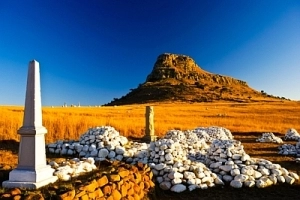Battlefields of Kwa-Zulu Natal - From the picturesque hills and rock formations of the Drakensberg Mountains to the shores of the Indian Ocean (Kwa-Zulu Natal) many historic battles were fought between the Voortrekker's and the Zulu’s, and the British Army and the Zulu Nation.
This area, now known as The Kwa-Zulu Natal Battlefields, is also famous for the Anglo-Boer Wars.

Isandlwana, Rorke's Drift, Spioenkop, Zulu wars, Shaka, Ladysmith, Dundee, Churchill, Blood River are some of the terms which are associated with this internationally renowned area of South Africa.
Besides taking an organized tour, there are several self-drive routes established to enable you to visit these historic towns and sites. Knowledgeable, friendly and accredited local guides are available and guarantee hour upon hour of captivating company.
The self-drive routes are:
- King Shaka's Way
- Remembrance Route
- Rifleman's Road
- Warrior's Trek
- Siege Salute
- Red Soldier's March
King Shaka's Way Route
King Shaka, when he was a young boy was outcast from his tribe and forced to find a home for himself and his mother. He grew up to become a great warrior, chief and finally King of the Zulu’s.
This area, Stanger, Eshowe, Melmoth and northwards to Ulundi offers visitors magnificent beaches, world-class game reserves and heritage sites and is rich in culture and tradition.
The Remembrance Route
The Remembrance Route begins from Pietermaritzburg through Greytown, Tugela Ferry, Dundee and onto the Ithala Game Reserve.
The British invaded Zululand in 1879 – the Zulu’s attacked the central column of the three major invading columns in a battle that lasted through the night at Isandlwana and Rorke’s Drift.
This area has an incredibly rich Zulu culture.
Rifleman's Road Route
1881 marked the first of the Anglo-Boer conflicts – the most humiliating of these battles was Majuba where the British lost 350 men, while the Boers only suffered 6 casualties!
Among the casualties was General Pomeroy-Colley. His grave can be seen in the lonely cemetery at Mt Prospect.
From Volkrust in the northwest, down through Newcastle, Dundee, Ladysmith, Colenso and Escourt, you will encounter fabulous scenery, generous hospitality, and tales of great courage and endurance that will enthrall you again and again.
Warrior's Trek Route
The Voortrekker’s were moving into the northern Natal area, headed by Piet Retief. They approached the Zulu King, King Dingane, for permission to settle on the land and a series of bloody encounters were to follow. The famous Battle of Blood River on 16th December 1838 was victorious for the 460 Voortrekkers who defeated a 15 000 strong Zulu army. A Voortrekker (Wagon) Laager, cast in bronze commemorates this battle.
The Ncome Museum is dedicated to fallen Zulu warriors and to Zulu culture.
From Ulundi through to Vryheid, on to Paulpietersburg and Ithala Game Reserve there is stunning scenery, warm mineral fountains, battlefields, game viewing and culture galore.
In a remote part of this region the last of the Bonaparte dynasty, Louis Napoleon Prince Imperial of France, met his fate as he fought with valor. A monument between Isandlwana and Vryheid remembers his bravery.
Siege Salute Route
The Siege Salute Route has a high concentration of historical sites encompassing Anglo-Boer War and several Voortrekker- Zulu War sites. Major towns along the route are Ladysmith, Colenso, Escourt and Winterton, at Dundee it merges with Red Soldier’s March.
Famous people such as Gandhi, Churchill and Louis Botha have traversed this area.
Probably the most beautiful of this route is the Ukhahlamba Drakensberg World Heritage Site, in the west. The Siege Salute overflows with beautiful landscapes, wildlife, bird life and adventures.
Red Soldier's March Route
At Fugitives Drift you will find the memorial to Lts Coghill and Melvill, who saved the Queen's Colors. From there you will have a view down into the Buffalo River valley where the survivors from Isandlwana struggled to cross the swollen river to reach Rorke's Drift.
At the centre of this route, Dundee has a varied history which is depicted in the impressive Talana Museum, set in a 20 acre heritage park, on the outskirts of the town. History has been brought alive by evocative museums on site.
